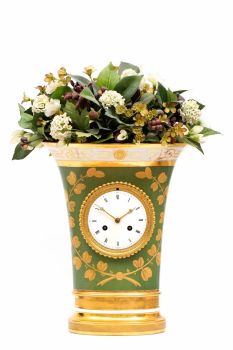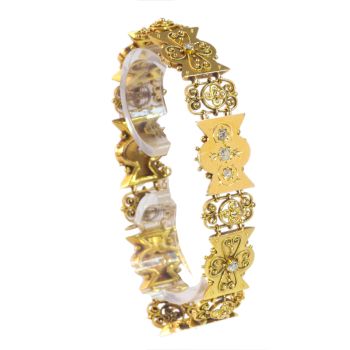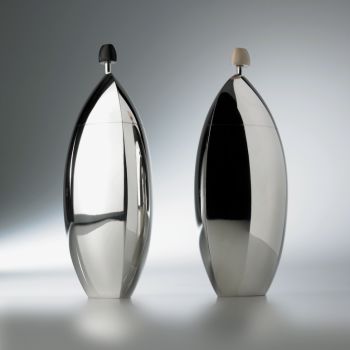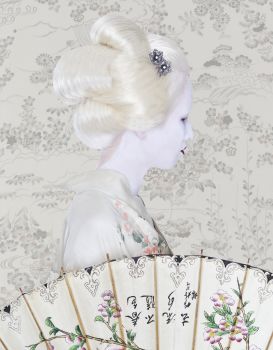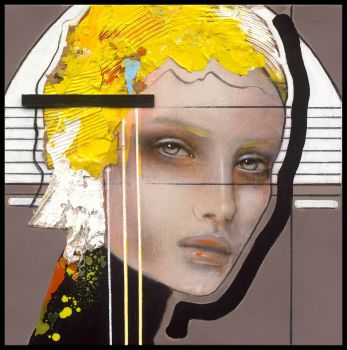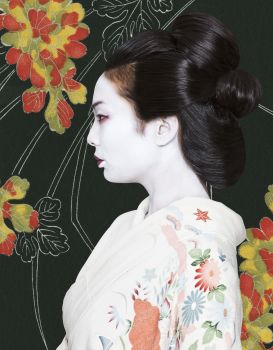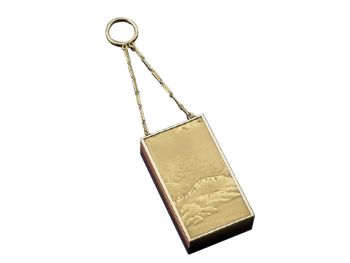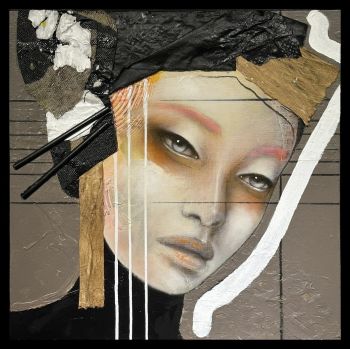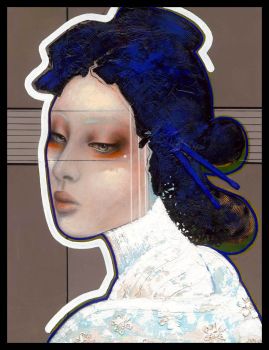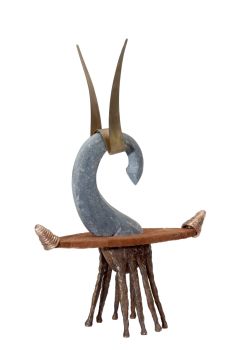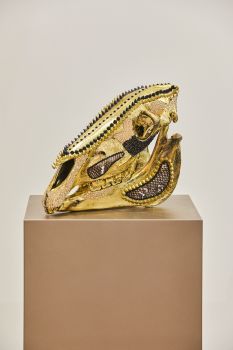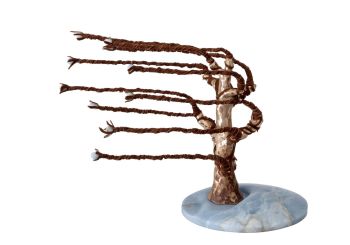A RARE LARGE JAPANESE LACQUERED LEATHER TELESCOPE 1750 - 1800
Unknown artist
Leather
Price on request
Zebregs & Röell - Fine Art - Antiques
- About the artworkA RARE LARGE JAPANESE LACQUERED LEATHER TELESCOPE
Edo Period, late 18th century
In four sections, the smaller innermost end fitted with a cow horn disc pierced with a central hole to maximise the use of the centre of the lens and the largest, outermost section finished with a copper disk with a central hole, all four sections of lacquered leather embossed and applied with gold lacquer on a black ground with bands of European style patterns including flowers, scrolling foliage and geometric designs, two covers for both ends.
L. 32 cm (retracted with the two end covers)
L, 87 cm (fully extended)
Note:
The first telescope to arrive in Japan was a gift from King James I (1566-1625) to the Shogun Tokugawa Ieyasu (1543-1616) in 1613. The Shogun made good use of his telescope during his battles and since then the Shogun and many of the country rulers asked the VOC, the Dutch East India Company based on the island of Deshima in the bay of Nagasaki, for telescopes as a tribute. At the end of the seventeenth century making of telescopes started in Japan, mainly in Nagasaki. The best known opticians during the Edo Period were Mori Nizaemon (1673-1754) of Nagasaki and Iwahashi Zenbei (1756-1811) of Osaka. The important role played by telescopes, of both European and Japanese manufacture, in the visual culture of the Edo Period is discussed in detail in Timon Screech, The Western Scientific Gaze and Popular Imagery in Later Edo Japan, (Cambridge, 1996).
For a similar example see NHK Service Centre and Siebold Council, Chikuzo 350-shunen Nagasaki Dejima ten (Exhibition commemorating the 350th anniversary of Deshima in Nagasaki, Tokyo and Osaka, 1986, cat. no. 134) for another example see Doris Croissant and Lothar Ledderose (eds.), Japan and Europe, 1543-1929 (pl. 61 in the exhibition catalogue: Berlin, Argon Verlag, 1993) there is an example in the Kobe Museum collection and two further examples of glass tube telescopes are in my catalogue Uit Verre Streken, Maastricht March 2015, cat. no. 59 and 60. - About the artist
It might happen that an artist or maker is unknown.
Some works are not to be determined by whom it is made or it is made by (a group of) craftsmen. Examples are statues from the Ancient Time, furniture, mirroirs, or signatures that are not clear or readible but as well some works are not signed at all.
As well you can find the following description:
•“Attributed to ….” In their opinion probably a work by the artist, at least in part
•“Studio of ….” or “Workshop of” In their opinion a work executed in the studio or workshop of the artist, possibly under his supervision
•“Circle of ….” In their opinion a work of the period of the artist showing his influence, closely associated with the artist but not necessarily his pupil
•“Style of ….” or “Follower of ….” In their opinion a work executed in the artist’s style but not necessarily by a pupil; may be contemporary or nearly contemporary
•“Manner of ….” In their opinion a work in the style of the artist but of a later date
•“After ….” In their opinion a copy (of any date) of a work of the artist
•“Signed…”, “Dated….” or “Inscribed” In their opinion the work has been signed/dated/inscribed by the artist. The addition of a question mark indicates an element of doubt
•"With signature ….”, “With date ….”, “With inscription….” or “Bears signature/date/inscription” in their opinion the signature/ date/ inscription has been added by someone other than the artist
Are you interested in buying this artwork?
Artwork details
Related artworks
Unknown artist
A pair of angels Antwerp, 17th century, Carrara marble17th century
Price on requestFrederik Muller
1 - 4 / 12Unknown artist
The Stamford Raffles Secretaires.1800 - 1813
Price on requestZebregs & Röell - Fine Art - Antiques
Unknown artist
A IVORY NETSUKE OF A DUTCHMAN HOLDING A COCKEREL18th century
Price on requestZebregs & Röell - Fine Art - Antiques
Unknown artist
A MARINE IVORY NETSUKE OF A DUTCHMAN HOLDING A CHINESE FAN18th century
Price on requestZebregs & Röell - Fine Art - Antiques
Unknown artist
A SMALL IVORY NETSUKE OF A DUTCHMAN WITH A DRUM1750 - 1800
Price on requestZebregs & Röell - Fine Art - Antiques
Unknown artist
A JAPANESE SMALL SAWASA 'PEACH-FORM' CRUCIBLE CUPearly 18th
Price on requestZebregs & Röell - Fine Art - Antiques
Unknown artist
A rare Japanese export lacquer medical instrument box1650 - 1700
Price on requestZebregs & Röell - Fine Art - Antiques
Unknown artist
AN IVORY NETSUKE OF A DUTCHMAN FROLICKING WITH A SMALL BOY18th century
Price on requestZebregs & Röell - Fine Art - Antiques
1 - 4 / 21Unknown artist
The Stamford Raffles Secretaires.1800 - 1813
Price on requestZebregs & Röell - Fine Art - Antiques
Unknown artist
A GILT-SILVER SRI LANKAN DOCUMENT SCROLL CONTAINER 19th century
Price on requestZebregs & Röell - Fine Art - Antiques
Unknown artist
A IVORY NETSUKE OF A DUTCHMAN HOLDING A COCKEREL18th century
Price on requestZebregs & Röell - Fine Art - Antiques
Unknown artist
A RARE COMPLETE INDIAN SADELI INLAID WORK AND WRITING BOX1800 - 1850
Price on requestZebregs & Röell - Fine Art - Antiques
Unknown artist
A SMALL IVORY NETSUKE OF A DUTCHMAN WITH A DRUM1750 - 1800
Price on requestZebregs & Röell - Fine Art - Antiques
Unknown artist
A JAPANESE MODEL OF A NORIMONO, A PALANQUIN1650 - 1700
Price on requestZebregs & Röell - Fine Art - Antiques
Unknown artist
A MARINE IVORY NETSUKE OF A DUTCHMAN HOLDING A CHINESE FAN18th century
Price on requestZebregs & Röell - Fine Art - Antiques
Unknown artist
A COLLECTION OF FOUR SRI LANKAN IVORY BIBLE BOXES18th century
Price on requestZebregs & Röell - Fine Art - Antiques
Unknown artist
AN IVORY NETSUKE OF A DUTCHMAN FROLICKING WITH A SMALL BOY18th century
Price on requestZebregs & Röell - Fine Art - Antiques
1 - 4 / 24Unknown artist
A large Japanese Imari porcelain 'VOC Groningen' dish1800 - 1925
Price on requestZebregs & Röell - Fine Art - Antiques
Engelbert Kaempfer
ENGELBERT KAEMPFER BOOK1651 - 1716
Price on requestZebregs & Röell - Fine Art - Antiques
1 - 4 / 24- 1 - 4 / 14
Unknown artist
IMPORTANT AND RARE LARGE INDIAN 'COMPANY STYLE' PAINTING ON IVORY DEPICTING A PARADE1850 - 1900
Price on requestZebregs & Röell - Fine Art - Antiques
 Curated by
Curated byDanny Bree
Unknown artist
A rare Japanese export lacquer medical instrument box1650 - 1700
Price on requestZebregs & Röell - Fine Art - Antiques
Unknown artist
A COLLECTION OF FOUR SRI LANKAN IVORY BIBLE BOXES18th century
Price on requestZebregs & Röell - Fine Art - Antiques
 Curated by
Curated byDanny Bree
Unknown artist
Japanese transition-style lacquer coffer 1640 - 1650
Price on requestZebregs & Röell - Fine Art - Antiques
Unknown artist
A silver spoon commemorating Juff’ Margareta van Hoorn1656 - 1694
Price on requestZebregs & Röell - Fine Art - Antiques
Unknown artist
Dutchmen in Miniature18th century
Price on requestZebregs & Röell - Fine Art - Antiques
1 - 4 / 12






